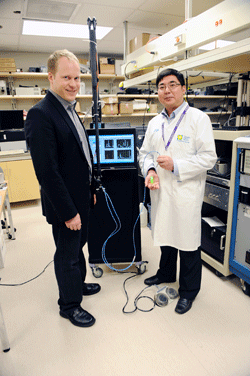Non-invasive cancer detection

Dr Haishan Zeng, senior scientist at BCCA and one of the co-inventors of a device for early cancer detection.
A new non-invasive cancer detection technology has been developed by cancer researchers and dermatologists at the BC Cancer Agency and the University of British Columbia. The technology is designed to assist in early detection of skin cancer and can be used by any health care professional—dermatologist, family doctor, nurse, or technician.
The device, called the Verisante Aura series, has been in development at the BC Cancer Agency for more than 6 years and has been tested on about 1000 lesions at the Skin Care Centre at VGH. Preliminary clinical results have so far demonstrated 100% efficacy in detecting malignant melanoma.
Using a light ray, the device measures 21 biomarkers to scan a mole or lesion to determine skin cancer in less than 2 seconds. It will help avoid unnecessary biopsies and detect more early-stage cancers that would otherwise go unnoticed. This platform technology is adaptable to other types of cancers such as lung, colon, cervical, and gastrointestinal cancers.
Vancouver’s Verisante Technology, Inc., a medical device company, has obtained the rights to the device.

